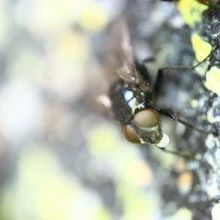Tens of thousands of tiny painters work in John Knuth’s studio in the Echo Park neighborhood of Los Angeles. He comes in every day to feed them a mixture of sugar water and watercolor paints, and they, in turn, cover his canvases with splotches of colored vomit.
The painters are flies, and Knuth is taking advantage of a quirk of the fly digestive process that causes the insects to regurgitate their prior meal in the course of ingesting a new one. Each blotch on the canvas is a “fly speck,” a spot of water, salivary enzymes, and partially digested, sweet paint. He props canvases up vertically under netting and the flies land on them, producing a dense array of marks.
Flies regurgitate because, unlike us, they cannot chew, according to Dana Nayduch, who studies how arthropods spread pathogens at the United States Department of Agriculture’s Agricultural Research Service in...
When a fly happens upon a tasty morsel, it uses specialized external teeth to scrape at it, loosening some fragments. It then spits up a slurry of water, salivary enzyme, and past meals “onto whatever [it’s] eating, whether it’s dog shit or your cheeseburger,” says Knuth. Once the fly’s meal is liquefied, it sucks it up.
“It’s exactly like chewing stuff and digesting stuff in your mouth before swallowing,” Nayduch says. Before a fly’s food makes it to the midgut—a portion of the digestive tract with high enzymatic activity and low pH somewhat like the human stomach—it travels into a holding area called the crop. Flies keep their crops filled with enough water to dissolve any meal they might eat. Regurgitating the contents of the crop repeatedly has the added bonus of mechanically mixing its contents. And each time the mixture passes through the esophagus, the flies can add more salivary enzyme to speed the digestion process.
Knuth did his first fly painting seven years ago and uses both houseflies and blowflies for his projects. Blowflies have their own habits. They regurgitate to ingest food, but they also “bubble,” repeatedly drawing regurgitated liquid in and out of their probosces. It’s not entirely clear why, but scientists suspect the process evaporates some of the liquid in their crop and concentrates their food before it passes on to their midguts. That tendency, too, could result in blotches on canvas, Nayduch speculated.
Knuth, born in Minnesota, says that the paintings are a merger of two of his childhood interests: “As a kid growing up I loved catching snakes and looking at Andy Warhol paintings,” he says. “I loved catching frogs and watching John Waters movies.”
Knuth’s first fly project involved tying tiny paper airplanes to flies and watching them buzz around. But eventually he “started to think of them as the mark maker and the paintbrush,” rather than muses. He estimates he has made more than 50 fly puke paintings.
With his fly paintings, his goal is to express transcendence. For one series of paintings, “Made in Los Angeles,” he chose colors he associates with the city— blues, smoggy grays, blacks, and sunset colors like reds, yellows, oranges, and pinks. “I like how they’re nonsocial insects,” he said. “I’m forcing them to do something unnatural. I like the thought that it’s like a city, or Los Angeles.”
As a vector biologist, Nayduch sees another layer of meaning. To her, fly specks represent an opportunity to spread disease. If a fly snacks on some poop and then regurgitates on someone’s lunch, it could pass on pathogens. “It could be a flying culture tube spreading bacteria,” she says. House flies and blow flies typically harbor gastrointestinal pathogens, such as Salmonella and E. coli, including the deadly O157:H7 strain. Researchers are looking into the possibility that flies could contaminate leafy crops, transferring bacteria from the barnyard to the field and contaminating the food supply.
The contrast between flies’ association with pathogens and the paintings they produce is part of the insects’ appeal for Knuth. “The paintings are beautiful, very delicate,” he said. “No one would see a painting without knowing the process and say they are gross, disgusting paintings.”
Videographer Andy Featherston filmed John Knuth as he and his blowflies created the
"Made in Los Angeles" series.
Interested in reading more?




